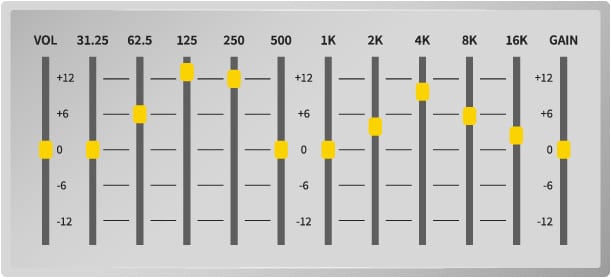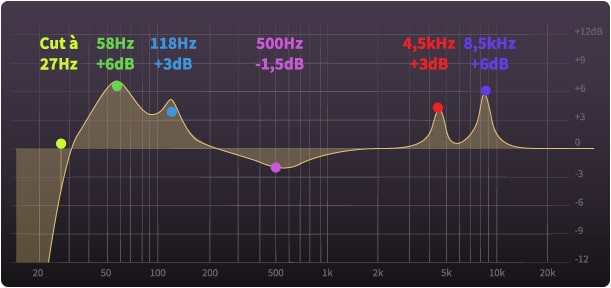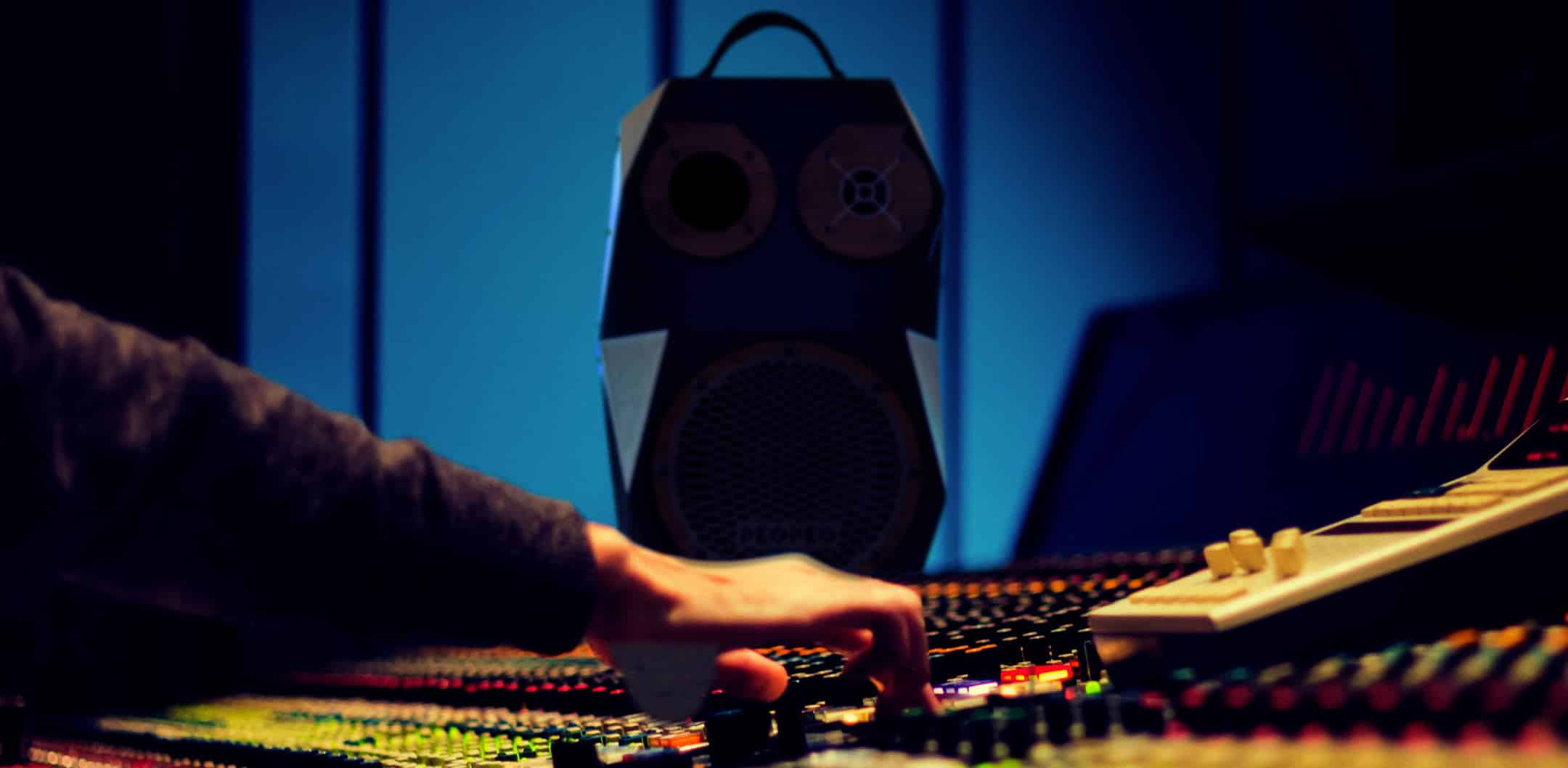READING TIME: 5 MIN
When we listen to music, we're not always aware of the complexity behind each note.
Perhaps you've heard of equalizers or audio filters? They contribute to the quality of our musical experience.
In this article, we'll explore these tools in detail, explaining how they can help improve the sound quality of your speakers.
All you need to know about equalizers (EQ), analog filters and digital audio filters
The world of music and sound is full of ever more innovative technologies. And these tools are constantly evolving, as in the case of equalizers, analog filters and digital filters.
You may have heard of an equalizer! Also known as EQ, equalizer, equalizer, EQ filter...
Call it what you like, we'll explain what it is!
First of all, an equalizer is a tool used to modify sound. It comprises analog filters and digital audio filters that change the frequency of the audio signal. These audio filters modify and refine the sound according to the parameters chosen.
The main function of an equalizer is to adjust the tone of an audio signal. In other words, it gives a piece of music a unique, personalized sound. For example, you can use an equalizer to add depth to certain notes, or to enhance certain instruments.
It is therefore possible to act on each frequency, or frequency range, and apply a specific treatment to it. Audio filters are used to adjust the sound and improve the sound quality of a recording or live performance. These filters can be analog or digital audio filters.
Now that you've got the hang of sound, you need to know what the 2 types of audio filter are:
An analog filter is a type of filter that uses resistors, capacitors and coils (RLC circuitry) to eliminate or reduce certain sound frequencies. It is less precise than the digital filter, but produces rich, natural and bold sounds. This is the passive crossover we used on the first version of our loudspeakers, the VOODOO Boombox.
The digital audio filter converts an analog signal into a digital version and applies algorithms to modify the sound more precisely and subtly. This is the most common type of filter today, and can be programmed to offer a wide variety of settings and functions. It is integrated into digital signal processors (DSP).
But what is a PSD?
DSP definition: DSP (Digital Signal Processing) is an electronic tool for processing digital signals to modify their characteristics. As we have just seen, digital filters are tools that process the digital signal using DSP. DSP algorithms can also be used for audio compression, echo cancellation and noise reduction.
Focus on digital audio filters
I hope you've understood everything, because we're going to move straight on to the types of equalizer that use digital audio filters. I promise, it's not complicated!
There are two types: graphic equalizers and parametric equalizers:
The graphic equalizer (or band equalizer) is a tool used to attenuate unwanted frequencies in an audio signal. It consists of potentiometers that can be used to increase or decrease specific frequency bands. Equalizers are available with 3, 5, 10, 15 or 31 bands.
Example of frequency processing with graphic equalizer :

The parametric equalizer lets you fine-tune the level of each frequency. It has three main parameters: center frequency, bandwidth (Q factor) and gain. By adjusting these parameters, it is possible to attenuate or reinforce specific frequencies in the audio signal. It's this type of high-performance equalizer that we've chosen to adjust the sound of our French bluetooth speaker, the VOODOO+.
Example of frequency processing with parametric equalizer :

Parametric equalizers have several types of filters with different effects on the audio signal:
- High-pass and low-pass filters pass high frequencies and reduce low frequencies as a function of the cut-off frequency (Bode diagram).
- Shelf filters allow you to increase or decrease the volume above or below a certain frequency.
- Bell or bandpass filters increase or reduce the volume of a specific frequency or frequency band.
What is a frequency?
The last mile to ultimate knowledge!
As you may have guessed, equalizers act on frequencies. These are expressed in Hertz (Hz), and correspond roughly to the tonality of a musical note. The higher the pitch of a sound, the higher its frequency.
But a sound rarely boils down to a single frequency; it's actually made up of a spectrum of frequencies.
The latter extends from 20 to 20,000 Hz, and is made up of different frequency ranges.
Here are the different frequency categories:
- Sub-bass (20 - 60 Hz): sub-bass is very low bass! In fact, they're more "felt" than heard. If you have a subwoofer at home, here's a good way to feel sub-bass. They will create a rumbling sound.
- Bass (60 - 250 Hz): low frequencies add "fatness" to a sound. There's nothing like a good bass in a rock band!
- Low Mid (250 - 500 Hz): low-mids often represent the low harmonics of instruments. However, this section can be confused with low frequencies. In mixing, this section is often cut, as it makes a song "muddy".
- Mid (500 - 2,000 Hz): there's a theory called "The Fletcher-Munson Curve". To sum up this concept, the human ear perceives mids more strongly than all other frequencies. As a result, when we listen to a song and an instrument really stands out, it's because it contains a lot of mids. In fact, this is the category in which the human voice falls!
- UpperMid (2K Hz - 4K Hz): in the mids family, this is probably the most sensitive region to the ear! This is where the essential timbre of a sound is found (guitar pick, drumstick, etc.).
- Presence (4K Hz - 6K Hz): this is where clarity and definition come into their own! Does the treble function ring a bell? That's where it's at!
- Brilliance (6K Hz - 20 Hz): less perceived by some, the brilliance region is made up entirely of harmonics! But use with care if you're boosting!
Now you know everything!
In conclusion, equalizers and audio filters are indispensable tools for working on sound quality.
Whether you're a sound engineer or a music-loving amateur, understanding the different options and frequency families is important for fine-tuning your sound.
The next time you listen to music, you'll appreciate the science and technology behind every note.

